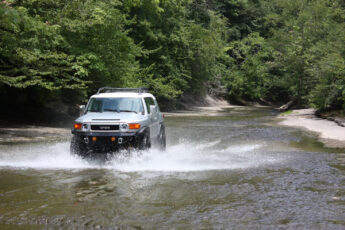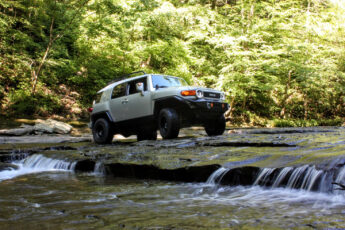Last Updated on 8 months
Discover the Importance of Proper Air Tire Pressure for Safe and Efficient Driving
You can easily find the recommended air tire pressure in your owner’s manual or a sticker inside the driver’s door.
Remember that the correct tire pressure of your vehicle is crucial for several reasons: it helps improve gas mileage, extends tire life, and ensures better vehicle handling.
With incorrect tire pressure, you risk having under-inflation, which causes the tires to wear out faster and makes the car more challenging to control. On the other hand, you also risk having over-inflated tires, which causes the tire tread to become more complicated than usual, reducing traction and resulting in uneven tire wear.
How can I check tire pressure?
You can check your tire pressure in two ways. “You can either use an air tire pressure gauge or a tire pressure monitoring system (TPMS).” If you have a TPMS, it can tell you the pressure in each tire. If you don’t have a TPMS, you can use a tire pressure gauge to check the pressure in each tire.

When using a tire pressure gauge, remove the cap from the tire valve and press the gauge onto the valve. The indicator will show you what the current pressure is in that tire.
How does temperature affect tire pressure?
Science teaches us that when it’s cold, molecules in the air slow down and stick together; when it’s hot, they speed up and move apart. And what this essentially means for us is that as the temperature rises, the pressure inside the tire increases.
 For example, if a tire is overinflated and there is an increase in temperature, the tire could explode. So, how much does temperature affect tire pressure? A good rule of thumb is that your tire pressure will change by around one psi for every 10-degree change in the air temperature.
For example, if a tire is overinflated and there is an increase in temperature, the tire could explode. So, how much does temperature affect tire pressure? A good rule of thumb is that your tire pressure will change by around one psi for every 10-degree change in the air temperature.
So, let’s say the temperature increases by 20 degrees: you can expect your tire pressure to increase by two psi.
Should I deflate my car tires in hot weather? It’s generally not a good idea to deflate your car tires in hot weather. You should be good if you follow the recommended tire pressure for your car.
What is worse: underinflated or overinflated tires?
Underinflated tires decrease gas mileage, increase tire wear, and reduce handling. Overinflated tires result in a bouncy ride, reduce traction, and increase blowout likelihood.
So which is worse? It depends on the situation.
Underinflated tires are generally more dangerous than overinflated ones, but the latter is as risky. So, our advice to you is to always follow the recommended tire pressure of your car at all times.
How Does Tire Pressure Affect Driving?
The appropriate tire pressure is a prerequisite for safety and driving performance.
How does tire pressure affect grip?
The gripping power of your tires on the road surface depends on many factors, including tire pressure. If your tires are underinflated, they will have less contact with the road and reduce grip, making it more difficult to control your car, especially in wet or icy conditions.
Overinflated tires can also reduce grip. The tire’s contact patch with the road becomes smaller, so there is less rubber in contact with the road. This scenario can make your car more likely to skid or slide on wet roads.
Maintaining the correct tire pressure ensures optimal grip and safety while driving.
How tire pressure affects fuel economy
Tire pressure also affects fuel economy.
Underinflated tires increase rolling resistance, so your car must work harder to move, reducing fuel efficiency by up to 3%. Overinflated tires can cause premature tread wear, leading to reduced fuel economy.
The wrong tire pressure can make your car uncomfortable to drive. Underinflated tires can make your vehicle feel bumpy and jarring. Overinflated tires can make your car feel skittish and unstable. The correct tire pressure, however, will give you a smooth, comfortable ride.
How does tire pressure affect tire wear?
Tire pressure impacts tire wear. If the pressure is too low, the tire will flex more and heat up, causing premature wear. On the other hand, if the pressure is too high, it can cause the tire to bounce and skid, leading to premature wear.
The best way to prevent premature tire wear is to check your tire pressure regularly and adjust it as needed.
Why maximum tire pressure is not the best option?
Maximum tire pressure is not the best choice because it can lead to excessive wear and tear on your tires. It can also cause your tires to lose traction, which can be extremely dangerous. The safest bet will always be the recommended tire pressure in your owner’s manual.
What PSI will a tire explode?
There is more than one factor that will cause the tire to explode: the tire’s type and size, the amount of pressure inside the tire, and the ambient temperature.
- In general, however, a tire is unlikely to explode unless the pressure inside it reaches approximately 200 PSI – at this point, the tire will burst.
- What to do if your tire pressure is too high or too low
- When your tire pressure is too high, you will experience reduced fuel economy and increased tire wear. You can release some air from your tires to bring the pressure down to the recommended level.
- On the other hand, when your tire pressure is too low, you will notice a decrease in handling and stability and an increase in tire wear. You can add air to your tires to bring the pressure up to the recommended level.
How to add air to a tire that is low on pressure

If your tire is low on pressure, you can go to your nearest service station to add air or do it with a tire inflator.
- First, connect the tire inflator to the tire valve.
- Then, please turn on the tire inflator and let it run until the desired amount of air has been added to the tire.
- Finally, disconnect the tire inflator from the valve and replace the cap.
5 Tips to keep your tires well-maintained
Tire maintenance is often overlooked, but keeping your tires in good condition is essential to ensure a safe ride. Here are a few practical tips to keep your tires well-maintained:
- Check the air pressure regularly. Avoid underinflation and overinflation.
- Inspect your tires for signs of wear and tear. It’s the right time to replace the tire if you see any damage.
- Rotate your tires regularly or at predetermined periods to help evenly distribute tire wear and extend the life of your tires.
- Keep an eye on the tread depth. When the tire tread gets too low, it’s time to change tires.
- Store your tires properly. If you’re not using your car long, park it in a cool, dry place.
Following these tips ensures that your tires are always in good condition and ready for the road.
-
Online Tire Shop
If you’re looking for high-quality tires, check out our wide array of tire inventory – and don’t hesitate to ask us if you need further assistance; we will be happy to help you.
Conclusion
Maintaining the correct air tire pressure is not just about inflating your tires; it’s about ensuring your safety, extending tire lifespan, and maximizing fuel efficiency. This comprehensive guide covers everything you need to know about air tire pressure and why it’s essential for your vehicle’s well-being. Remember, a well-inflated tire is your vehicle’s vital lifeline on the road.
Ready to ensure your tires are correctly inflated for safe and efficient driving?
Visit Giga Tires today to explore our tire selection and ensure you have the right tires to maintain the correct air pressure. Your journey to safer and more efficient driving begins with Giga Tires!
Ready to dive deeper into the world of tires? Explore more informative articles on Giga Tires’ website to enhance your tire knowledge!
- Unlocking The Mysteries Of Tire Symbols: Discover The Meaning Behind Tire Numbers With Confidence
- New Winter Tires Mastery: Your Indispensable Companion For The 2021-2022 Season
- Spotlight On Small SUV Tire: Giga Tire’s Top Picks For Small CUVs & Small SUVs
FAQs
Why is proper air tire pressure critical?
Proper air tire pressure is crucial because it affects your vehicle’s safety, handling, and fuel efficiency. Underinflated tires can reduce traction, increase braking distance, and even cause tire damage. Overinflated tires can cause a harsher ride and less grip on the road. Maintaining the correct tire pressure ensures your tires’ safety and longevity.
How can I find the recommended air pressure for my tires?
Your vehicle’s recommended air tire pressure can usually be found in your vehicle’s owner’s manual or on a sticker inside the driver’s door jamb. You can also check the manufacturer’s website or consult a tire professional for guidance.
How often should I check my tire pressure?
It’s recommended to check your tire pressure at least once a month and before long trips. Temperature changes can affect tire pressure, so it’s crucial to monitor it regularly to ensure it stays within the recommended range.
What happens if I drive with low air tire pressure?
Driving with low tire pressure can lead to several issues, including reduced fuel efficiency, uneven tire wear, increased blowout risk, and compromised handling and braking performance. It’s essential to address low tire pressure promptly.
Can I check tire pressure myself, or should I visit a professional?
You can check your tire pressure using a tire pressure gauge readily available at auto supply stores. It’s a straightforward process, but most service centers and tire shops offer complimentary tire pressure checks if you’re unsure or prefer professional assistance.













 Français
Français Español
Español